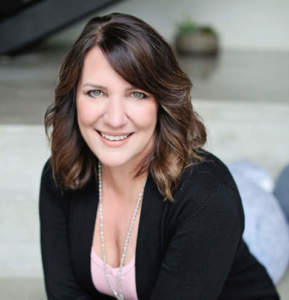Designing For High-Quality Video Conferencing
Posted January 16, 2021 in Special Features

When you search the web on how to design the background for your home office video chats, you’ll find lots of technical information about changing up a virtual background, but very little professional design advice. Since it’s become common to have video meetings from home this last year, I’m offering some hard-found advice about how you can look like a professional came to your home office and staged your background setting.
First, try to clear off as much of your desk or table surface. If you have a window behind you, be sure to close the blinds or curtains. Otherwise, your viewers may see a dark shadow. Face a window for natural lighting if possible. Otherwise you can add a halo light or ring light to your desk which will give you a look of professional lighting.
Try to arrange your chair so that you are about 24 to 30 inches from your screen. This will help you to appear more engaged in the meeting. Remember to smile! The computer, camera, or phone should be capturing you so that your face is the main focus. View yourself on your camera to be sure that the ceiling isn’t being given too much attention and that it is adjusted correctly.
The fun part for me is being able to show off one’s theatrical abilities and design the set! You will want the space to feel like everything belongs purposefully. Look at your space through the camera on screen. A beautiful space that is lived in at home might be great for living but overwhelming for video. And remember that sometimes there is such a thing as too much creativity in showing off a background space. Don’t let the space take over the attention you bring.
Real-life backgrounds offer cohesiveness, colors that complement each other and your skin tone. It is important to think about how the background contributes to the message.
My go-to furniture this year for backgrounds is the bookcase. The bookcase creates the illusion of an office even if at home. Open-shelving is also popular because of the simplicity. Either backdrop creates the impression that you are knowledgeable and professional.
You might notice that guest journalists on the television often have organized and well-placed books or even awards in the background. It’s okay to show off these accomplishments. The idea is to arrange items for visual impact. This is staging.
If you have books, you might organize them by color or wrap the binders in similarly colored papers. Books can be horizontal or vertical. Be careful to mix the direction up just enough so that your bookcase doesn’t appear overly staged.
You can add some art objects or a plant for visual relief. Check that there is a balance and that one or two objects don’t bring too much attention. Vary height and visual weight of objects in the background. Mix new with old and aim for texture over pattern. Check that the background isn’t distracting by viewing it through the camera.

By now you most likely have figured out the best angles for the camera, the benefits of lighting and what works best for your background. If you have questions you’d like to see addressed in my future columns, please email me at DianneMorrisHomes@gmail.com I’ll try to write about as many topics as I can address.